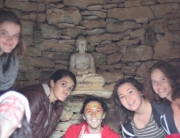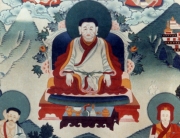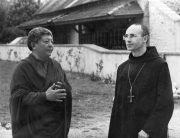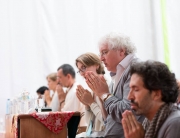Meeting a bodhisattva is a form of practice
One can summarize the Buddha’s teaching in multitudes of ways. Practicing the dharma involves changing our habits and dissipating obscurations of the mind, in other words, changing our way of understanding to leave space for wisdom. If we take inspiration from Gampopa, the path unfolds in four steps:
– First, we must understand the teaching and begin to integrate its meaning.
– Then, we must apply the teaching without letting ourselves become distracted by the various disturbances we might encounter.
– This process clarifies our mind and dissipates ignorance.
– Progressively, our perception transforms such that we connect with mind’s wisdom.
This is, of course, the context in which we will meet Karmapa. Such a meeting is a practice in and of itself.
A State of Mind to Develop
Concrètement, comment suivre les enseignements du Karmapa, prendre les vœux de bodhisattvas, recevoir In concrete terms, how do we follow Karmapa’s teachings, take bodhisattva vows, receive the Chenrezig empowerment, and practice with him? First of all, we must cultivate a state of mind that renders us an appropriate vessel to receive these transmissions.
First, let’s cultivate an awareness of the preciousness of this event. Meeting Karmapa, a bodhisattva of such accomplishment, presupposes having united many conditions, if we hold to the idea of causality (karma). His presence is solely motivated by the suffering of being and the wish to dissipate the causes for this suffering. He is the very incarnation of compassion and discernment. Creating a connection with him necessarily means getting in tune with this, and, conscious of suffering and its causes, wishing that beings may be liberated from these causes. In so doing, we realize how much we are limited in ability to accomplish this; we are not yet capable. This is where the path truly begins. It is through transforming our vision of ourself and of others that we can dissipate the misunderstandings that obscure the mind. Receiving instructions and transmission from Thaye Dorje forwards this transformation.
Being Present to the Essential
On the basis of this state of mind, we do not allow ourselves to be overtaken by distraction during the event. Distraction takes on two forms in this case: judgment and expectations. Of what? Rarely anything related to lofty philosophical considerations! Rather, it’s the seat we couldn’t get in the teaching hall, the volunteer who snapped at us, the organization that’s not up to par, etc. The list is long. Expectations, judgments, and emotions arise no matter what—this is not the problem. Here, the importance lies in maintaining awareness of oneself so as not to succumb to all these states of mind that drag us down. Our practice is that of cultivating presence with the essential: being available to receive what Karmapa has to offer us.
Receiving the Blessing
Whatever the transmission, as the saying goes, “we receive the blessing.” It doesn’t happen through miracles or fantastical experiences. Blessing is the spontaneous expression of Karmapa’s activity; it touches anyone open to receiving it. Whether we are by ourselves or amidst two thousand other people before a bodhisattva does not make any difference. It is our state of mind that allows us to be a proper vessel. Jigme Rinpoche compares blessing to a seed. It is a kind of potential, a capacity, a cause. Once the seed is planted, it is up to us to nurture it through practice, i.e. through listeing, reflection, and meditation. Maintaining presence free from judgment, reminding ourselves of who Karmapa is through cultivating attentive listening to his tranmission, we become aware of this fertile ground where the seeds of enlightenment can be planted.
Developing Wishes
Wishes guide the bodhisattva along the path; they are a practice in and of themselves. They are the mind’s capacity to generate positive causes for oneself and others. They are easy to put into practice; it suffices to formulate the thought of what we wish to achieve at the end of the day. Wishes are of such great importance that it is necessary to practice them intensely by uniting the conditions that allow them to come to be. One of these conditions is called the support, he whom we call to witness our wishes (traditionally we say “all the Buddhas”).
The time we pass with Karmapa is a unique occasion to form wishes. But let’s not be stingy; let’s develop vast wishes—wishes for the long haul, for ourselves and for others. Let’s be inspired by Samantabhadra’s King of Wishing Prayers or Rangjung Dorje’s Mahamudra wishes. Whether they are spoken out loud or simply recited mentally, let’s express them with determination and confidence that, sooner or later, through our practice, we will harvest their fruits.
Meeting the Karmapa is a rare and precious opportunity. Let’s remain aware of ourselves; let’s remember who Karmapa is; let’s make wishes. In this way, we can stay relaxed and receive that which the holder of the Kagyü lineage offers us.
Puntso
Puntso










Leave A Comment